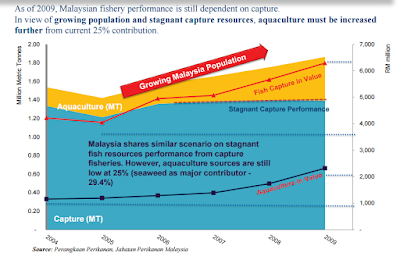Aqua - water
Culture - to grow
Aquaculture is farming of aquatic organisms in a controlled environment or partially controlled for the purpose of production for part or the whole life cycle of the organism.
History of Aquaculture

3500 B.C.
Aquaculture began in China. They raise carp, a hardy fresh-water species, which is still raised in many parts of the world today. They also developed the use of polyculture, the art of growing different species together.
2000 B.C.
Drawings dated back to 2000 B.C, indicate that Egyptians practiced aquaculture. They cultured tilapia, a warmwater species which is still cultured in many countries today.
800 B.C.
Archeological evidence indicates that the Mayan Indians of Central America cultured fish in ponds and canals.
100 B.C.
Romans practiced both freshwater and saltwater aquaculture. Fish such as trout and mullet were raised in ponds called "stews".
400 A.D.
Hawaiian Natives established an organized system of aquaculture which consisted of a variety of fresh and saltwater systems to raise several species.
1100 A.D.
Aquaculture began in Central Europe with the culture of carp.
1800 A.D.
France began experimenting with modern aquaculture technologies. By the mid 1800s, coldwater trout and salmon were cultured in France and other European countries.
1850 A.D.
Trout and salmon were cultured in the United States for the purpose of restocking lakes and streams for anglers.
*source: The Council for Agricultural Education. Aquaculture. Alexandria, VA, 1992.
AQUACULTURE PRODUCTION STATUS
Global total capture fishery production in 2014 was 93.4 million tonnes, of which 81.5 million tonnes from marine waters and 11.9 million tonnes from inland waters. China remained the major producer followed by Indonesia, the United States of America and the Russian Federation.
*source: 2016 The State of World Fisheries and Aquaculture
Aquaculture Production Status in Malaysia
3500 B.C.
Aquaculture began in China. They raise carp, a hardy fresh-water species, which is still raised in many parts of the world today. They also developed the use of polyculture, the art of growing different species together.
2000 B.C.
Drawings dated back to 2000 B.C, indicate that Egyptians practiced aquaculture. They cultured tilapia, a warmwater species which is still cultured in many countries today.
800 B.C.
Archeological evidence indicates that the Mayan Indians of Central America cultured fish in ponds and canals.
100 B.C.
Romans practiced both freshwater and saltwater aquaculture. Fish such as trout and mullet were raised in ponds called "stews".
400 A.D.
Hawaiian Natives established an organized system of aquaculture which consisted of a variety of fresh and saltwater systems to raise several species.
1100 A.D.
Aquaculture began in Central Europe with the culture of carp.
1800 A.D.
France began experimenting with modern aquaculture technologies. By the mid 1800s, coldwater trout and salmon were cultured in France and other European countries.
1850 A.D.
Trout and salmon were cultured in the United States for the purpose of restocking lakes and streams for anglers.
Within the last century, aquaculture has expanded nationally and globally. A huge selection of fish, shellfish and plants are cultured for a variety of purposes.
*source: The Council for Agricultural Education. Aquaculture. Alexandria, VA, 1992.
AQUACULTURE PRODUCTION STATUS
Global total capture fishery production in 2014 was 93.4 million tonnes, of which 81.5 million tonnes from marine waters and 11.9 million tonnes from inland waters. China remained the major producer followed by Indonesia, the United States of America and the Russian Federation.
For the first time since 1998, anchoveta
was not the top-ranked species
in terms of catch as it fell below
Alaska pollock.
Four highly valuable groups (tunas,
lobsters, shrimps and cephalopods) registered
new record catches in 2014. Total
catches of tuna and tunalike species were
almost 7.7 million tonnes.
The Northwest Pacific remained the
most productive area for capture fisheries,
followed by the Western Central Pacific, the
Northeast Atlantic and the Eastern Indian
Ocean. The situation in the Mediterranean
and Black Sea is alarming, as catches have
dropped by one-third since 2007, mainly attributable
to reduced landings of small pelagics
such as anchovy and sardine but with most
species groups also affected.
World catches in inland waters were
about 11.9 million tonnes in 2014, continuing
a positive trend that has resulted in a 37% increase
in the last decade. Sixteen countries have annual
inland water catches exceeding 200 000 tonnes,
and together they represent 80% of the world total.
Aquaculture has been responsible
for the impressive growth in the supply of
fish for human consumption. Whereas aquaculture
provided only 7% of fish for human
consumption in 1974, this share had
increased to 26% in 1994 and 39% in 2004.
Production of aquatic animals
from aquaculture in 2014 amounted to
73.8 million tonnes, with an estimated
first-sale value of US$160.2 billion.
China accounted for 45.5 million
tonnes in 2014, or more than 60% of
global fish production from aquaculture.
Other major producers were India, Vietnam, Bangladesh and Egypt.
Aquatic plant farming, overwhelmingly
of seaweeds, has been
growing rapidly and is now practised in
about 50 countries.
*source: 2016 The State of World Fisheries and Aquaculture
Aquaculture Production Status in Malaysia



